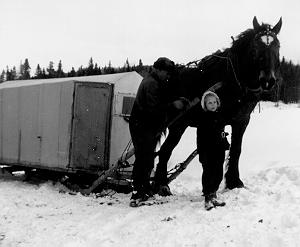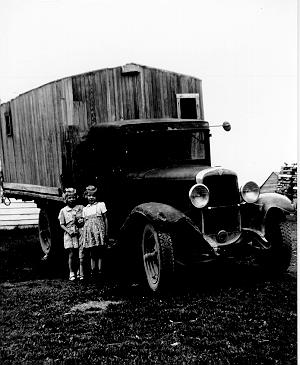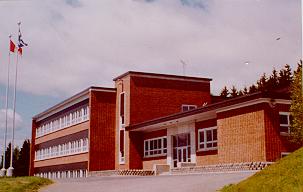| Early Gaspesian families had a hard
struggle to merely survive and life was filled with daily
chores for young and old. Therefore, very few people had
the opportunity to learn to read and write. However, the
desire for education was strong, so in the early 1800's
Gaspesians requested and received permission to build
their first schools. One was constructed near the present
St. Paul's Church, in Gaspe. During the next half century
most surrounding communities built one-room school-houses
in which students were taught the basics. A chosen few
were able to continue beyond grade 6 and go to high
school, which in the early days was only available in
Quebec City. Even in the 1930's high school was reserved
for the privileged few whose parents could afford to pay
their room and board. Traveling to and from Gaspe,
although only a ten minute drive today, was out of the
question on a daily basis at that time. Records show that as early as the 1820’s some children from York went "across the river," to attend a school under the jurisdiction of the Royal Institute for the Advancement of Learning, taught in Wakeham by John Eden. Some schooling was provided in private homes during the mid-1800’s, independent of the government educational system. Many children learned to read and write, and all learned the farming and lumbering skills necessary for survival. Early in the 1860’s the York School Commission was formed. School was being taught in York Center around 1863 in the home of Benjamin Annett, the house presently owned by Francis Annett. Later, children were taught in an "old well-house" on the property of William Patterson, now owned by Harry Stewart. These schools were situated about two or three miles east of Sunny Bank. Because of its size, York was divided into school house divisions number 1 and 2. In Sunny Bank school began about 1869, and was taught by Annabella Boyle in the home of Edmund Patterson. She taught there for 3 years until, in 1872, the first Sunny Bank school-house was constructed on the site of the apartment building presently owned by Gerard LaPierre. Miss Boyle continued to teach there until 1876. According to correspondence from the secretary-treasurer, William Thomas Laws, to the government in 1874, the commissioners at the time were: Mr. Abner Coffin, chairman, Mr. Charles Grant, Mr. Henry Eagle, Mr. Joshua Falle, and Mr. James Suddard. The Sunny Bank School, division 2, served Sunny Bank and Brassett.
The original one room school-house proved insufficient by 1908, when it was decided at a public meeting that the increased number of children in the division warranted changes. Because of the exploding population of the western portion of Sunny Bank, it was decided to construct a third school. No action seems to have been taken on that decision, and it was later decided to add a second classroom to the number 2 school instead. At a meeting of the School Board on April 24, 1915, construction of a 20 foot addition to the existing schoolhouse was approved. Alfred Palmer's tender of $385 for supplying the materials and constructing the addition was accepted, and work was completed that summer. The following year two teachers were hired in the Sunny Bank School to teach the pupils from grades 1 to 7. The head teacher received $320 per year and taught grades four to seven. The assistant, who taught grades one, to three, received $150. Initially schools employed only "teachers," who taught several grades, supervised recess and lunch hour, and was responsible for making wood fires and keeping the building clean. Often one of the older boys would come early and light a fire, and mothers would volunteer to scrub the school occasionally. Also, the men of the neighborhood would collectively cut and haul the firewood needed for heat. The rest of the operation was the sole responsibility of the teacher whose salary, until 1914, never exceeded $300 per year. That year it was decided that supplying firewood would be given to tenders, and that someone would be hired to clean the school every second week. The latter was accepted by Mrs. Henry Grant for the sum of seventy-five cents per cleaning.
Our educational system has undergone many changes. At that time each room contained several classes and frequently had more than thirty students. Pupils learned to work together, with the older ones helping the younger ones. Books were scarce, and the avid readers covered the entire school library by grade four or five. Seldom were there enough textbooks to go around, and in the earlier years, slates were used for arithmetic and other drills. There were no computers, activity days, professional days, storm days, and certainly no year end trips. School went from nine to four, and those who weren’t interested in attending were simply sent home. As more money became available, scribblers and pencils came into common use, and notes were given by the teacher. Discipline was severe, with the strap being used freely to deter disruptive behavior. Games such as "prisoner's base" and "king's castle", dominated the school yard at recess and noon. Construction was once again undertaken in 1935, when a new school, the east half of the present structure, was built. It was a two story, two-classroom school house, with inside bathroom facilities and many conveniences not found in the older building. Shortly after, because of a declining student population, it was decided to close the school in York Center and to transport all students from York to the Sunny Bank school house. In 1938, the west half of the four-classroom building was completed. This structure looked much as it remains today. All of York's children from grades one to ten were taught there. During the spring and fall, students from what had been known as school house division number one, were driven to school in a covered box on the back of a truck. A similar enclosure was constructed for a horse sleigh to transport students during the winter. Shortly after Henry Mullin had taken over as driver in 1941, the school board purchased a snowmobile for winter use, and Mr. Mullin constructed a box on his 1931 half ton truck for spring and fall. This primitive bus service provided by the York School Commission was one of the earliest in the Gaspe area.
Gaspe Consolidated High School opened in 1956, housing grades one to eleven under the same roof. The new school had a gymnasium, a specially equipped chemistry laboratory, library, kitchen facilities, and modern classrooms. Many of the small schools in the area were closed and school busses were used to transport students to and from Gaspe. That same year all except grades one to four vacated the Sunny Bank School. Finally, much against the will of the people of Sunny Bank, on September 3, 1958, our school closed its doors for the final time. From that day hence all students from Sunny Bank have been bussed to Gaspe to receive their education. Today, our English students attend Grades one to six at Gaspe Elementary School, one of five elementary schools in the region. All high school students go to the Gaspe Polyvalente, a large educational institution serving about eleven hundred students, with about one quarter of them English speaking. Gaspe also has a CEGEP where students from the entire Gaspe Coast are able to begin their college education.
For many years the abandoned school house in Sunny Bank stood empty. Finally in the late 1960's it was purchased by Mr. Lapierre who converted it into an apartment building. It has been painted and renovated, and now houses four families. |



